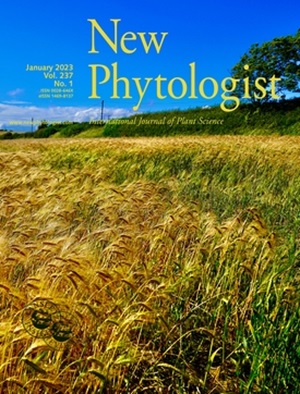Specific redox and iron homeostasis responses in the root tip of Arabidopsis upon zinc excess
IF 8.3
1区 生物学
Q1 PLANT SCIENCES
引用次数: 0
Abstract
- Zinc (Zn) excess negatively impacts primary root growth in Arabidopsis thaliana. Yet, the effects of Zn excess on specific growth processes in the root tip (RT) remain largely unexplored.
- Transcriptomics, ionomics, and metabolomics were used to examine the specific impact of Zn excess on the RT compared with the remaining root (RR).
- Zn excess exposure resulted in a shortened root apical meristem and elongation zone, with differentiation initiating closer to the tip of the root. Zn accumulated at a lower concentration in the RT than in the RR. This pattern was associated with lower expression of Zn homeostasis and iron (Fe) deficiency response genes. A distinct distribution of Zn and Fe in RT and RR was highlighted by laser ablation inductively coupled plasma-mass spectrometry analysis. Specialized tryptophan (Trp)-derived metabolism genes, typically associated with redox and biotic stress responses, were specifically upregulated in the RT upon Zn excess, among those Phytoalexin Deficient 3 (PAD3) encoding the last enzyme of camalexin synthesis. In the roots of wild-type seedlings, camalexin concentration increased by sixfold upon Zn excess, and a pad3 mutant displayed increased Zn sensitivity and an altered ionome.
- Our results indicate that distinct redox and iron homeostasis mechanisms are key elements of the response to Zn excess in the RT.
锌过量对拟南芥根尖氧化还原和铁稳态的响应
锌(Zn)过量对拟南芥初生根生长有负面影响。然而,锌过量对根尖特定生长过程的影响在很大程度上仍未被研究。转录组学、离子组学和代谢组学研究了锌过量对RT和剩余根(RR)的具体影响。锌过量暴露导致根尖分生组织和伸长区缩短,分化开始于根尖附近。Zn在RT中的积累浓度低于RR。这种模式与锌稳态和铁(Fe)缺乏反应基因的低表达有关。激光烧蚀电感耦合等离子体质谱分析表明,锌和铁在RT和RR中有明显的分布。特异性色氨酸(Trp)衍生的代谢基因,通常与氧化还原和生物应激反应相关,在锌过量时在RT中特异性上调,其中包括编码camalexin合成最后酶的Phytoalexin Deficient 3 (PAD3)。在野生型幼苗的根中,锌过量后camalexin浓度增加了6倍,并且pad3突变体表现出对锌的敏感性增加和电离体的改变。我们的研究结果表明,不同的氧化还原和铁稳态机制是RT中锌过量反应的关键因素。
本文章由计算机程序翻译,如有差异,请以英文原文为准。
求助全文
约1分钟内获得全文
求助全文
来源期刊

New Phytologist
生物-植物科学
自引率
5.30%
发文量
728
期刊介绍:
New Phytologist is an international electronic journal published 24 times a year. It is owned by the New Phytologist Foundation, a non-profit-making charitable organization dedicated to promoting plant science. The journal publishes excellent, novel, rigorous, and timely research and scholarship in plant science and its applications. The articles cover topics in five sections: Physiology & Development, Environment, Interaction, Evolution, and Transformative Plant Biotechnology. These sections encompass intracellular processes, global environmental change, and encourage cross-disciplinary approaches. The journal recognizes the use of techniques from molecular and cell biology, functional genomics, modeling, and system-based approaches in plant science. Abstracting and Indexing Information for New Phytologist includes Academic Search, AgBiotech News & Information, Agroforestry Abstracts, Biochemistry & Biophysics Citation Index, Botanical Pesticides, CAB Abstracts®, Environment Index, Global Health, and Plant Breeding Abstracts, and others.
 求助内容:
求助内容: 应助结果提醒方式:
应助结果提醒方式:


